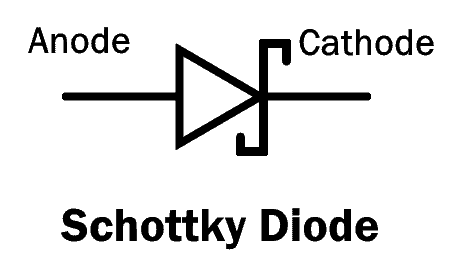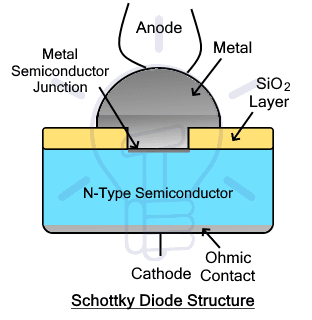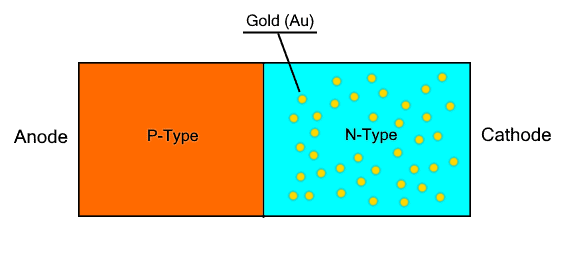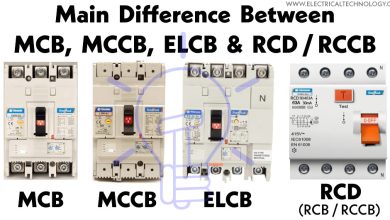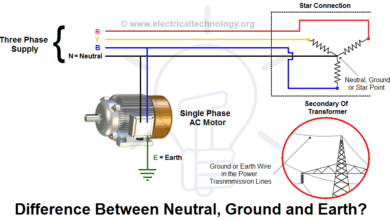Difference Between Schottky Diode and Fast Recovery Diode
What is the Difference Between Fast Recovery Diode and Schottky Diode?
Schottky diode and fast recovery diode are both types of diodes having very fast switching speed. Both of them are designed for high-frequency applications and both of them find their uses. However, they have certain differences and advantages over one another.
Let’s look at their basics before going into the differences between the Schottky diode and the fast recovery diode.
Related Posts:
- Difference Between Schottky Diode and Shockley Diode
- Difference Between Photodiode and Phototransistor
Schottky Diode
Schottky diode is a type of diode formed by a junction between metal and semiconductor to have a fast switching speed. The junction formed is shortly known as the MS junction. It is a unipolar diode because only one type of majority carrier is responsible for current flow. It is also known as a hot carrier or Schottky barrier diode. They are extremely fast having very low power consumption. It is designed for low-power RF applications up to 100 GHz.
Structurally Schottky diode is made from an N-type semiconductor layer & a metal such as aluminum, tungsten, Platinum gold, etc. The P-type semiconductor layer has a lower forward voltage characteristic but at the cost of high reverse leakage current, therefore N-type semiconductor is preferred. The forward voltage of the Schottky diode ranges between 0.4 to 0.6 volts.
The main purpose of the MS junction is to have very low junction capacitance that allows it to have a very high switching speed due to its low reverses recovery time in the range of 0.1 to 10 ns. The switching speed can be easily modified by varying the width of the junction using the doping concentration in the semiconductor layer as well as the type of metal being used.
As far as the symbol is concerned, the vertical bar on the cathode side of a normal diode is modified into an ‘S’ shape. The two terminals anode and cathode are internally connected with metal & semiconductor respectively.
Fast Recovery Diode
A fast recovery diode is a type of PN junction diode that has a very fast reverse recovery time. It is also known as a fast diode. It is used for rectification of high-frequency signals up to 100 kHz.
It has a similar structure as a conventional PN junction diode. The fast switching speed is achieved by having recombination centers inside the N-type semiconductor layer. Gold is used as a recombination center that helps in recombining the holes (slow-moving charge carriers) that are moving back to their side. Their lifetime is reduced and the depletion region is drained of the charge carriers thus blocking the reverse current.
The addition of gold as recombination centers reduces the recovery time but increases the reverse leakage current of the diode thus it has limitations. But its PN junction is capable of blocking higher voltages than the Schottky diode.
Key Differences Between Schottky and Fast Recovery Diodes
The following table shows the comparison between Schottky & Fast Recovery diodes.
| Schottky Diode | Fast Recovery Diode |
| It is a metal & semiconductor junction diode. | It is a PN junction diode with gold doping as recombination centers. |
| It is a unipolar diode i.e. only one type of majority carriers is used for current flow. | It is a bipolar diode both electrons and holes participate in the current flow. |
| It has a positive terminal or anode as metal & negative terminal or cathode as an N-type semiconductor. | Its anode terminal is a P-type semiconductor while the cathode is an N-type semiconductor |
| The MS junction has very thin depletion region | The PN junction has a wider depletion region. |
| It has lower junction capacitance. | It has relatively higher junction capacitance. |
| It has an ultra-high switching speed used for signals up to 100 GHz. | It has a high switching speed used for rectification of signals up to 100 kHz. |
| Its reverse recovery time is around a few nanoseconds to 10 ns. | Its reverse recovery time is about 10ns to 200 ns |
| It has a low forward voltage of around 0.4 to 0.6 ns. | It has a relatively higher forward voltage of about 1.3 to 3.6 volts. |
| It has higher efficiency. | It has lower efficiency. |
| It can withstand maximum reverse voltage up to 150 volts. | It can withstand large reverse voltages up to 1200 volts. |
| It is used for the rectification of high-frequency signals. | It is used for RF applications. |
Related Posts:
Main Differences between Schottky & Fast Recovery Diode
Definition
- Schottky diode is a type of diode made from the junction between metal and semiconductor.
- A fast recovery diode is a type of PN junction diode having gold doping for reducing reverse recovery time.
Structure
- Schottky diode is a two-layer device made of metal & N-type semiconductors.
- A fast recovery diode is made of two layers of semiconductor i.e. P-type & N-type with gold doping in its N-layer.
Current flow
- Schottky Diode is a unipolar device where only a single type of majority carrier is responsible for current flow.
- The fast recovery diode is bipolar where the current flow is due to the flow of both minority & majority carriers.
Junctions
- The Schottky diode has a junction between a metal such as aluminum, tungsten, Platinum gold, and an N-type semiconductor.
- The junction in a fast recovery diode is a conventional PN junction between a P-type semiconductor & N-type semiconductor.
Switching Speed
- Due to the MS junction in the Schottky diode, it has a very thin depletion region & low junction capacitance. Therefore it has an ultra-high switching speed of up to 100 GHz
- Due to recombination centers in the semiconductor of the fast recovery diode, it has a high switching speed but is fairly slower than the Schottky diode.
Reverse Recovery Time
- The Schottky diode has a very short reverse recovery time of around a few nanoseconds. It is due to its unipolar nature as well as no PN junction to store charge carriers.
- The fast recovery diode has a comparatively large recovery time than the schottky diode around 100 ns but it is shorter than the conventional diode due to gold doping.
Reverse Voltage
- The MS junction of the Schottky diode cannot withstand high reverse voltage. Thus it should be less than 150 volts.
- The PN junction of the fast recovery diode can withstand high reverse voltage up to 1200 volts.
Power Consumption
- The Schottky diode has a low forward voltage of around 0.4 to 0.6 volts. Therefore it has very low power consumption.
- The fast recovery diode has a high forward voltage of around 1.3 to 1.6 volts. Therefore it has a higher power consumption
Related Posts:
- Difference Between LED and LDR
- Difference between Photodiode and Photoresistor (LDR)
- Difference between LED and Photodiode
- Difference Between Phototransistor and Photoresistor (LDR)
- Differences Between Encoder and Decoder?
- Difference Between NPN and PNP Transistor
- Difference Between BJT and FET Transistors
- Difference Between Multiplexer (MUX) and Demultiplexer (DEMUX)
- Difference Between Thermistor and Thermocouple
- Difference Between Sensor and Actuator
- Difference between Sensor and Transducer
- Difference Between Clipper and Clamper Circuit
- Difference Between Transistor and Thyristor (SCR)?
- Difference between Active and Passive Components
- Difference Between JFET and MOSFET
- Main Difference Between Clipper and Clamper Circuit
- Difference Between D-MOSFET and E-MOSFET
- Difference Between BJT and FET Transistors
- Difference between RTD and Thermocouple
- Symbols of Diodes
- Applications of Diodes

